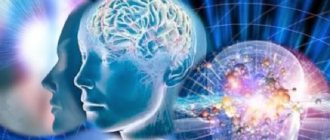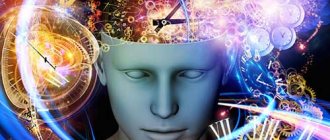Doctors at the Leto Mental Health Center provide assistance to patients diagnosed with amentia. In the field of psychiatry, this symptom complex occurs quite often. It is a severe disorder of consciousness in which a person's intellectual ability to synthesize is impaired.
Amentia is characterized by the division of all spheres of perception into the smallest particles. The patient does not see the world as a whole. He is not able to collect what is happening around him into a single picture. At the same time, all types of orientation suffer, including in one’s own psyche and personality.
It is impossible to communicate and interact productively with patients with amentia. Their condition periodically worsens due to hallucinations, movement disorders, and emotional disturbances.
It is unacceptable to expect that a person will overcome this disease on his own. If it occurs, you should immediately contact a psychiatrist. To make an appointment with experienced doctors at the Leto clinic, call 8(969)060-93-93 . The cost of consultations at the center is affordable.
Stunned or lethargic
When faced with dazedness or inhibition, patients react poorly to their environment and speech, and they become indifferent to everything they see, hear and feel. If the disease worsens, simple stupor can turn into a coma
, that is, a complete “turn off” of consciousness. After exiting this state, the patient will remember absolutely nothing about what happened. The patient may fall into a coma if he has diabetes, kidney or liver failure, as well as some other diseases.
Prevention
Clinical recommendations for the prevention of PCES to prevent its development:
- complete and timely examination of the patient before surgery,
- timely detection of concomitant diseases,
- fighting bad habits,
- proper nutrition with limited fatty foods,
- regular 4-6 meals a day,
- enriching the diet with dietary fiber,
- taking vitamin-mineral complexes,
- normalization of body weight,
- active lifestyle,
- prevention of constipation,
- regular monitoring by a gastroenterologist after surgery.
Compliance with these recommendations allows you to minimize the risk of developing PCES and save the patient from torment and suffering.
PCES is a pathology caused by digestive disorders of a functional or organic nature. The symptoms of the disease are varied and nonspecific. Functional disorders are treated conservatively, while organic disorders are treated surgically.
Delirium (hallucinations)
This syndrome means that the patient may experience various kinds of hallucinations - deceptions of the senses and perception. For example, a person may hear voices that are not there or see something that does not exist. At the same time, the patient is completely confident that everything is happening for real, and cannot distinguish reality from illusion. In this regard, the patient may experience severe behavioral deviations. They can manifest themselves in both positive and negative emotions, depending on the nature of the hallucinations.
For this reason, the patient can be dangerous both to himself and to others and society in the broad sense of the word. When “returning to reality,” the memory of hallucinations is preserved, but the memory of reality is most often not. This symptom often manifests itself in severe poisoning and infectious diseases.
Reasons for the development of the disorder
Amentia syndrome is a psychosis, most often caused by unfavorable internal factors. So, usually its occurrence is facilitated by severe physical or mental disorders. Sometimes it is caused by exogenous causes such as poisoning with toxic substances.
A mild degree of pathology may be a consequence of severe diarrhea, dehydration, poisoning, previous surgery, or bleeding. Severe amentia is the result of hyperthyroidism, dangerous organic brain lesions, advanced intoxication in alcoholics and drug addicts, and long-term infections.
Most often, amentia is detected in sepsis and head injuries. It affects people with schizophrenia and bipolar disorder. With these diagnoses, there are no clearly defined symptoms. Symptoms are mixed. This makes diagnosis somewhat difficult.
Oneiric state (“waking dream”)
This symptom is associated with an influx of vivid hallucinations, most often with fabulous, impossible and even absurd content. The patient sees all these images and pictures, but, unlike delirium
, maintains the position of an external observer and does not actively participate in the “action”.
At the same time, the patient’s orientation in space and understanding of his own personality are disrupted. The memory of illusions is partially preserved. This symptom often occurs with congenital heart disease and certain types of infections.
Complications of menorrhagia
The most common complication of menorrhagia is anemia, a condition that is associated with the acute loss of large amounts of blood in a short time or chronic blood loss without adequate restoration of iron stores. In case of acute bleeding, the patient complains of weakness, dizziness, and a metallic taste in the mouth. With chronic bleeding, a woman often does not show any complaints, despite the fact that her hemoglobin level may be very low (about 70 g/l), since she considers this level to be her “norm”
Therefore, the patient, as well as the doctor during the interview, should pay attention to indirect signs of chronic blood loss: brittle nails, increased hair loss, pale skin, dark circles under the eyes, impaired concentration and performance, slow thinking
Another common complication of menorrhagia is diseases associated with pelvic inflammation. The blood itself has a neutral environment, while the vagina, which is normally densely populated with all kinds of bacteria, has an acidic environment. With prolonged menorrhagia (more than 8 days), the pH of the vagina changes, which creates a favorable environment for the rapid proliferation of opportunistic microflora. Rising higher, the bacteria colonize the mucous membrane of the cervical canal and uterus, provoking an inflammatory reaction. This aggravates the course of menorrhagia, preventing successful treatment.
In some cases, uncorrected acute menorrhagia can be fatal. This is associated with acute blood loss.
Amentive clouding of consciousness (amentia)
This is a condition in which the patient completely loses all ability to navigate both in space and in himself and his experiences. Everything he sees and feels is perceived in fragments and is not something whole. The processes of thinking and understanding what is happening are disrupted. of delirium occur
and
oneiric state
, causing fear.
The speech of such people can be thoughtless and incoherent. They are also characterized by a sharp change in activity, that is, excitement can suddenly give way to apathy
and helplessness. My mood also changes unusually often.
The amental state can be quite long - up to several months, and it is sometimes replaced by short periods of “enlightenment”. The dynamics of the disease completely depend on the physical condition of the patient, and this condition itself is characteristic of sepsis and cancer intoxication. In general, the very fact of an amental state, as a rule, indicates a serious illness in the patient.
What it is?
We can talk about the described disorder if the individual’s speech is impaired, there is no coherence, and mental activity is disrupted.
In psychiatry, amentia is a syndrome of severe confusion, manifested by a violation of all types of orientation, a disorder of personal self-identification, motor dysfunction, and incoherence of speech and mental activity. The most important feature of the syndrome in question is the inability to draw conclusions and loss of associative connections. The patient's speech is meaningless and monotonous, does not contain emotional coloring and intonation modifications. Quite often, a monotonous whisper is replaced by a rather loud speech in a sing-song voice. In addition, the speech of patients is characterized by inconsistency and reproduction of individual words.
Amentia - what is it? The analyzed term in psychiatric science arose in the 19th century thanks to the research of neuropathologist-psychiatrist T. Meinert, who identified the specific state of foggy consciousness as a separate syndrome. He described amentive syndrome as a jumble and incoherence of thinking processes. In addition, I discovered a relationship between the disorder in question and motor activation, the appearance of hallucinatory ideas and delusional states, and loss of orientation.
Modern psychiatry has made the boundaries of this condition clearer, which has significantly simplified diagnosis and made it possible to differentiate the symptoms of a disorder of mental functioning from twilight consciousness or classic delirium.
E. Kraepelin, an eminent figure in psychiatry, studying amentia, concluded that patients’ perceptions are preserved, but they cannot harmonize their own thoughts with each other or with their experience. In addition, patients are not able to combine logic and their own concepts. At the same time, they try hard to be aware of what is happening, but as a result of being easily distracted, they become incapable of methodical observation. The perception of individuals suffering from amentia syndrome is characterized by a mixture of disparate passages that do not provide the patient with a holistic vision of what is happening. As a result, negative emotions arise: incomprehensibility, vagueness, helplessness. Patients do not realize that they are unwell. In addition, patients with amentia also cannot understand what is happening around them.
Twilight stupefaction
Twilight stupefaction is considered one of the most specific symptoms in medicine in general. It is characterized by complete loss of memory for the period of morning and evening (twilight). The patient's ability to navigate in space is severely impaired, severe hallucinations are possible, which the patient is afraid of, as well as incoherent speech and muttering. Fortunately, this symptom is quite rare and is not accompanied by a complete loss of consciousness (unlike, for example, epilepsy).
A characteristic feature of mental confusion in somatic diseases is that some of the memories are erased. The darknesses themselves are short-lived and proceed dynamically, often moving from one to another and to a normal state.
Treatment
Treatment for amentia involves careful care, proper nutrition, physical therapy, and medications. The home environment is unsuitable for this type of patient due to their agitated state, frequent aggressiveness, untidiness, possible suicide attempts, and the need for emergency measures that are difficult to implement at home. Therefore, they should be immediately placed in a special medical facility.
Careful monitoring of cardiac activity and increased nutrition with light, easily digestible foods are indicated. If you refuse food, you should not hesitate to administer artificial nutrition through a tube. Soothing baths, sleeping pills, strengthening medications, and psychotropic drugs are useful.
Remembering the possibility of relapses during the recovery period, it is necessary at this time to especially protect the patient with amentia from any strong external stimuli; only with the complete restoration of his mental and physical health can he be discharged from the hospital. Then complete rest is recommended under good sanatorium conditions. Only 3-4 months after recovery can the patient be allowed to return to his work, starting it not in its full extent, but gradually getting involved in it.
The information presented in this article is intended for informational purposes only and cannot replace professional advice and qualified medical care. If you have the slightest suspicion that you have this disease, be sure to consult your doctor!
Glossary of terms
In this section we have collected all the terms that you might encounter in this article. Gradually, we will collect from these explanations a real dictionary of a narcologist-psychiatrist. If some concepts remain unclear to you, leave your comments under the articles on our site. We will definitely help you figure it out.
Amentive clouding of consciousness (amentia)
– a form of clouding of consciousness, characterized by the patient’s confusion, incoherence of his speech and thinking, and disorder of movements. With amentia, complete clarity of consciousness does not occur at all, communication with the patient becomes impossible.
Hallucination
– images arising in the patient’s mind without external conditions. As a rule, hallucinations appear with the use of psychoactive substances (alcohol, drugs, many psychotropic medications), significant fatigue, as well as with mental disorders and neuralgia. Regular and prolonged hallucinations are a common occurrence in schizophrenia and are significant complications of its clinical picture.
Delirium
– a type of mental disorder associated with impaired consciousness (at first, clouding syndromes appear, then up to coma).
Accompanied by true hallucinations
(mainly visual), illusions, delusions,
senestopathies
and other symptoms. After recovering from delirium, the patient may forget both real events and hallucinations. A patient with delirium can be dangerous to himself and others.
True hallucinations
– a type of hallucination in which an imaginary object is located in objective space. They differ from illusions in that they do not occur in people who do not have mental disorders.
Comatose state (coma)
- a borderline state between life and death that threatens life. It is characterized by the patient’s loss of consciousness, lack of reactions to external stimuli or a significant decrease in such reactions, loss of reflexes, disturbances in breathing and pulse, and temperature regulation.
Oneiric state (oneiroid, schizophrenic delirium)
– mental pathology associated with a qualitative disturbance of consciousness (the so-called “oneiric disorientation”. The patient sees detailed pictures, experiences pseudo-hallucinatory sensations that are confused with reality. The patient is lost in time and space, may be confused in his own personality. Many include people around them in their fictional situation One of the characteristic signs of oneiroid is considered to be the transformation of the human “I” - for example, when a person begins to consider himself a tree or a bird.
Schizophrenic delirium
– the same as
oneiric state (oneiroid)
.
Complications
Complications of scurvy are numerous. Recovery may be incomplete, and then the disease leaves behind incurable disorders. This happens when gum lesions are deep and widespread. Then the mucous membrane cannot completely transform, the gums remain bare.
Scorbutic ulcers are, especially in some cases, ugly scars that significantly impede movement. A certain number of patients retain this difficulty in movement, depending on the contraction of the tendons and stiffness of the joints.
Persistent muscle atrophy and more or less extensive areas of anesthesia may be observed.
When people are overcrowded, when other epidemic diseases (typhoid, dysentery, cholera, malaria) are already rampant, scurvy has especially severe forms.
Among the complications that may arise during the normal course of the disease, the most important and most frequent are the following: bronchopneumonia, pulmonary embolism, very extensive necrosis of the lungs, almost constant in some epidemics. Complications from the lungs develop without affecting the general condition, almost undetected by sharp signs. The same applies to exudative pleurisy observed during the course of scurvy.
With scurvy, simple or hemorrhagic pericarditis with a rapid course may occur. Myocarditis occurs frequently in all forms of the disease.
Bones are also the site of complications. Caries and necrosis are sometimes observed following deep ulcerations. Most often, after the jaws, the bones of the extremities are affected, especially the bones of the hand and foot.
The visual apparatus is subject to a curious lesion known as night blindness. Other eye complications (blepharitis, conjunctivitis, iritis, keratitis) are nothing specific.
During the recovery period, profuse rashes of boils or ecthyma pustules are often observed.
Types, classification
An unambiguous generally accepted method of classification has not yet been developed. There is an approximate breakdown of the types of violation. The criterion for division is the prevailing symptoms.
- Hallucinatory form. Hallucinatory symptoms predominate. Usually true hallucinations: voices that seem to exist objectively, visual images, smells. It is possible to change painful experiences during the course of the pathology. With schizophrenic etiology, pseudohallucinations are observed: subjective images that exist “in the head.” Voices, “alien” thoughts. These are so-called mental hallucinations.
- Delirious form. Delirium predominates. Abnormal illogical judgments that cannot be dissuaded by any arguments. The symptom is fragmentary, a coherent system is not built, which is typical for transient disorders of the thought process.
- Catatonic form. Accompanied by alternating stupor (complete lack of motor activity, maintaining muscles in the position that preceded the episode) and psychomotor agitation. It is relatively rare.
- Mixed form. Celebrated most frequently. All types of symptoms are present, in approximately equal proportions. In other varieties, clinical signs are also found in full. But there is a pronounced “distortion” in qualitative terms. For example, strong hallucinations with partially preserved speech, the ability to adequately respond emotionally (as far as possible in such a situation), etc.
Types of amentia may suggest the origin of the problem, but not always. Classification is used to determine the causes of formation.
Diagnostics
For any disease of the genitourinary system, a medical history and examination of the patient are first carried out. Then, depending on the clinical picture, diagnostic tests are prescribed, which may include:
- Urine tests: general, according to Nechiporenko.
- General blood analysis.
- Urine culture for flora (to determine the sensitivity of infectious agents to antibiotics).
- Creatinine and urea in blood serum.
- Erythrocyte sedimentation rate.
- Ultrasound of the kidneys and bladder.
- Intravenous urography.
- Computed tomography of the pelvic organs.
Reference! Additionally, cystoscopy may be prescribed - an endoscopic examination, during which the inner surface of the bladder is examined.
Urinary tract infection: specific development in women and men
Due to differences in the anatomical structure, urinary tract diseases occur differently in women and men.
Infections in women are caused by the structure of the urethra: it is wider and shorter than in men. Therefore, it is easier for infections to penetrate not only into the urethra, but also into the bladder. Urethritis (inflammation of the urethra) and cystitis (inflammation of the bladder) occur more often in women than in men. This is also facilitated by the close proximity of the anus, vagina and urethra. Infections can be introduced into the urethra both from the anus (with insufficient or improper hygiene) and from the vagina during sexual intercourse.
In men, the urethra also performs a sexual function (seminal fluid passes through it during ejaculation), so it is longer and narrower than in women. In addition to the bladder, the ducts of the testicles also open into the urinary canal. The urethra passes through the prostate gland, an organ involved in the production of sexual secretions and seminal fluid. Infections in men occur when infected during sexual intercourse, as well as from pathological enlargement of the prostate gland, when the upper part of the urethra is compressed, stagnation of urine occurs and, as a result, an inflammatory process.
Flow
The course of urolithiasis can not only be intersected by the above-mentioned complications, but even the own symptoms of stones (pain, hematuria) often reach such intensity at a certain moment that this increases the danger of the disease.
The duration of urolithiasis cannot be determined, even approximately, since there are too many factors that slow down the development of the disease or accelerate its outcome. Left to its own devices, the disease most often ends in death, usually due to some form of acute or chronic urinary poisoning. With a long course, the development of pyelitis and pyelonephritis is possible.
Treatment
Syndromic pathogenetic and symptomatic therapy should begin in the first days, weeks and months of life before an accurate diagnosis of a hereditary metabolic disease is established.
General principles for treating hyperammonemia include:
1) limiting the intake of protein into the body;
2) increased supply of the body with carbohydrates and lipids;
3) improvement of ammonia metabolism through the use of benzoic and phenylacetic acids, as well as the additional introduction of arginine;
4) sterilization and cleansing of the intestines to reduce the formation of ammonia under the action of the bacterial enzyme urease, which is produced by intestinal microflora;
5) adequate fluid balance in the body;
6) removal of excess ammonia from the body using hemodialysis or PCD.
If severe hyperammonemia is detected in a newborn child in serious condition, enteral and parenteral protein intake stops completely. As the child's condition improves, protein intake is limited to the minimum physiological requirement.
To reduce proteolysis and provide sufficient energy, parenteral administration of glucose is carried out - 60 kcal/(kg-day) and lipids - 60 kcal/(kg-day).
Reducing the production of ammonia by intestinal microorganisms is achieved through the use of a cleansing enema, oral administration of aminoglycosides (gentamicin 3-5 mg/kg) and the drug Duphalac.
To optimize urea metabolism, intravenous administration of a 10% glucose solution 35 ml/kg over 90 minutes is recommended, which contains sodium benzoate (250 mg/kg), sodium phenylacetate (250 mg/kg), arginine chloride (10% solution 6 ml/kg). 2 hours after the start of the infusion, it is necessary to determine the ammonia content in the blood. If the ammonia level has returned to normal, then the started infusion therapy should be continued for 24 hours. If hyperammonemia persists, hemodialysis or PCD is indicated.
Indications for immediate hemodialysis or exchange blood transfusion:
1) the presence of a second degree coma with a decrease in muscle tone, a decrease in spontaneous movements while maintaining a reaction to painful stimuli;
2) five times the normal level of ammonia;
3) a combination of hyperammonemia with progressive encephalopathy.
The information presented in this article is intended for informational purposes only and cannot replace professional advice and qualified medical care. If you have the slightest suspicion that you have this disease, be sure to consult your doctor!
Diagnostics
Diagnosis of PCES begins with listening to the patient’s complaints and collecting an anamnesis of the disease. It is necessary to find out how long after cholecystectomy the first symptoms appeared? When was the operation performed?
Specialists analyze family history and find out what gastrointestinal diseases the patient’s relatives have.
- Physical examination methods include questioning and examining the patient, as well as palpation of the abdominal organs.
- In a general clinical blood test - a decrease in the number of red blood cells, hemoglobin, an increase in leukocytes and an increase in ESR.
- Biochemical blood test - determination of total bilirubin, its fractions, ALT, AST, alkaline phosphatase, blood glucose, blood amylase.
- Coprogram - analysis of stool for the presence of undigested food fragments, fat, coarse dietary fiber.
- Microscopic, bacteriological and biochemical studies of bile are carried out according to indications.
- CT and MRI allow visualization of the vessels and organs of the abdominal cavity.
- Ultrasound of the abdominal cavity reveals stones in the bile ducts, their inflammation, expansion and deformation.
- Additional methods include chest radiography, which is performed to exclude pneumonia and mediastenitis.
- X-ray contrast examination of the stomach determines the presence of ulcers.
- Gastroscopy and FGDS are performed to exclude other pathologies of the digestive system.
- Scintigraphy can detect bile circulation disorders.
- Electrocardiography.
- Transabdominal ultrasonography.
- Multifractional duodenal intubation.
- Holegraphy.
- Manometry of the sphincter of Oddi.
- Cholangiopancreatography.










